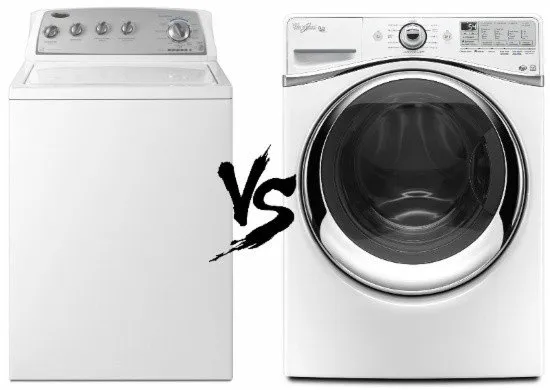Top load vs Front load washing machine


Pros of a Front-Load Washer
Front-load washers typically use less energy and water than a standard top-load model.
They are more gentle on clothes because the tumbling washing action is less stressful than rotating agitation.
Since there is no center agitator, front-load washers typically have larger capacity drums to accommodate more laundry and large items like comforters.
While not all front-load washers are stackable, most manufacturers design them so a dryer can be placed on top for space efficiency.
Cons of a Front-Load Washer:
Front-load washers are more expensive than top-load models and often require more maintenance.
Due to the design, they trap moisture, especially around the door gasket, which can lead to problems with mold and odor.
Unlike top-load washers, most front-load washers lock while in use to prevent water overflow, prohibiting the addition of last-minute laundry.
Because of the slower, more gentle action of a front-load washer, the cycle time is significantly longer than a top-load washer.
Overview of Top-Load Washers
There are two types of top-load washers: the standard top-loader with a center agitator in the vertical drum and the high-efficiency model that has a disc agitator or impeller in the bottom of the drum.
Both have a large door on top of the washer that rises and remains in a near-vertical position while the user adds/removes clothing or detergent.
Top-load washers are easy to load and unload due to their waist-height opening for most users. They can be difficult to use for anyone with a shorter stature or confined to a wheelchair. Items can be added throughout the wash cycle in both standard and HE top-load washers.
Pros of a Top-Load Washer:
Top-load washers clean clothes more quickly.
You can easily stop and start the cycle to add more items or allow items to soak.
The machines require less maintenance and are easier to clean.
A top-load washer is less expensive to purchase than a similarly-sized front-load washer.
Cons of a Top-Load Washer:
Top load washers, especially standard center agitator models, often use more energy and water.
The cleaning action is more aggressive, causing fabrics to wear out more quickly, and the capacity is usually less for large items.
A top-load washer can't have a dryer stacked on top
Top-Load vs. Front-Load Washer: Major Differences
Appearance and Installation
Because top-load washers do not have a large door on the front, they have a smoother, sleeker look than front-load washers.
Top-load machines must be placed side by side with a dryer unless you purchase a smaller compact stacking washer/dryer combo.
Front-load washers' front doors have thick glass inserts that allow users to see the clothing, a good way to track the progress of the wash cycle. Front-load washers can be stacked with a dryer to fit into closets or small areas, though this arrangement is not always necessary.
Best for Appearance and Installation: Tie
Top-load and front-load washers both tend to have a similar stark, industrial look. While not unpleasant, it is not considered a true home design element in the laundry room. All of the water, gas, and electrical connections will be the same for both top-load and front-load washers.
Cleaning Power and Wear and Tear on Clothing
Top-load washers twist and swirl clothing against paddles creating friction to remove dirt and stains. Most high-efficiency top-load washers use an impeller plate at the bottom of the washer tub to move clothes through the water and detergent.
Standard top-loaders use a central agitator with paddles to spin clothing briskly, causing more wear and tear. Front-load washers tumble clothes against each other in the water to remove dirt and stains.
Gravity works in the washer's favor, causing the clothes to tumble against each other in an up-and-down motion to scrub away stains similar to hand-washing.
Best for Cleaning Power and Preserving Clothes: Front-Load Washer
A front-load washer's gentle tumbling effect cleans better and creates less stress on the clothing. Second best: A top-load washer without a central agitator creates less wear and tear on fabrics.
FAQ
Do front-load washers last longer than top-load?
Not usually. The life expectancy of a standard top-load washer is 14 years. The average life expectancy of a high-efficiency front-load or top-load washer is 11 years.
Which is better, a top-load or front-load washer?
Both types of washers do a good job and selection depends on your budget and laundry room space. Front-load washers cost more to purchase and require more maintenance than top-load washers, but they use less energy, provide better cleaning, and less wear and tear on clothes than top-load washers.
Why are front-load washers more expensive than top-load?
A top-load washer uses "free" gravity to drain water from the drum and less complicated mechanisms to house the components. Front-load washers require a leak-proof door and additional pumps to remove water since the drum is horizontal, not vertical.